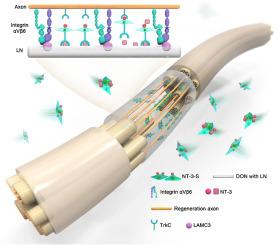基于脱细胞视神经支架的外周神经组织样体移植用于恢复大鼠后肢的感觉和运动功能。
IF 12.8
1区 医学
Q1 ENGINEERING, BIOMEDICAL
引用次数: 0
摘要
周围神经损伤(PNI)涉及感觉和运动功能的丧失,修复难度很大。虽然自体神经移植仍是修复周围神经损伤的金标准,但供体侧的破坏是不可避免的。本研究设计了由基于许旺细胞(SC)的神经营养素-3(NT-3)递送系统和具有自然定向通道的脱细胞视神经(DON)组成的外周神经组织实体(PNTs),以研究 PNTs 在神经再生中的作用机制。蛋白质组分析和 mRNA 测序显示,PNTs 具有通过趋化、粘附和内在调动三种机制促进神经再生的优势。结果表明,层粘蛋白γ3(LAMC3)在PNTs中构建了一个富含NT-3的局部池,为TrkC阳性SCs的定植、轴突被吸引到缺损/移植物区域以及再髓鞘化创造了有利条件。此外,PNTs 中的 LAMC3 还能通过整合素 aVβ6 快速促进轴突粘附,并能精确引导长轴突到达靶组织。此外,NT-3/TrkC、LAMC3/整合素 aVβ6 和支架之间的相互作用可协同激活受损神经元中的 PI3K-AKT 信号通路,进一步激发神经元的内在再生动力,最终实现快速神经支配,改善后肢的感觉和运动功能。本文章由计算机程序翻译,如有差异,请以英文原文为准。

Transplantation of peripheral nerve tissueoid based on a decellularized optic nerve scaffold to restore rat hindlimb sensory and movement functions
Peripheral nerve injury (PNI) involving the loss of sensory and movement functions is challenging to repair. Although the gold standard of PNI repair is still the use of autologous nerve grafts, the destruction of the donor side is inevitable. In the present study, peripheral nerve tissueoids (PNTs) composed of a Schwann cell (SC)-based neurotrophin-3 (NT-3) delivery system and a decellularized optic nerve (DON) with naturally oriented channels were engineered to investigate the mechanism of PNTs in nerve regeneration. Proteomic analysis and mRNA sequencing revealed that PNTs have the advantage of promoting nerve regeneration by the three mechanisms of chemotaxis, adhesion and intrinsic mobilisation. The results demonstrated that a local NT-3-enriched pool was constructed by laminin γ3 (LAMC3) in PNTs, creating a niche for the colonization of TrkC-positive SCs, attraction of axons to the defect/graft area, and remyelination. In addition, LAMC3 in PNTs can rapidly promote axon adhesion through integrin aVβ6 and can precisely guide long projecting axons to target tissues. Furthermore, the interactions among the NT-3/TrkC, LAMC3/integrin aVβ6 and the scaffold synergistically activate the PI3K-AKT signalling pathway in damaged neurons, further stimulating the intrinsic regenerative drive within the neurons to ultimately achieve the rapid reinnervation and the improvement of sensory and movement functions in the hindlimb.
求助全文
通过发布文献求助,成功后即可免费获取论文全文。
去求助
来源期刊

Biomaterials
工程技术-材料科学:生物材料
CiteScore
26.00
自引率
2.90%
发文量
565
审稿时长
46 days
期刊介绍:
Biomaterials is an international journal covering the science and clinical application of biomaterials. A biomaterial is now defined as a substance that has been engineered to take a form which, alone or as part of a complex system, is used to direct, by control of interactions with components of living systems, the course of any therapeutic or diagnostic procedure. It is the aim of the journal to provide a peer-reviewed forum for the publication of original papers and authoritative review and opinion papers dealing with the most important issues facing the use of biomaterials in clinical practice. The scope of the journal covers the wide range of physical, biological and chemical sciences that underpin the design of biomaterials and the clinical disciplines in which they are used. These sciences include polymer synthesis and characterization, drug and gene vector design, the biology of the host response, immunology and toxicology and self assembly at the nanoscale. Clinical applications include the therapies of medical technology and regenerative medicine in all clinical disciplines, and diagnostic systems that reply on innovative contrast and sensing agents. The journal is relevant to areas such as cancer diagnosis and therapy, implantable devices, drug delivery systems, gene vectors, bionanotechnology and tissue engineering.
 求助内容:
求助内容: 应助结果提醒方式:
应助结果提醒方式:


